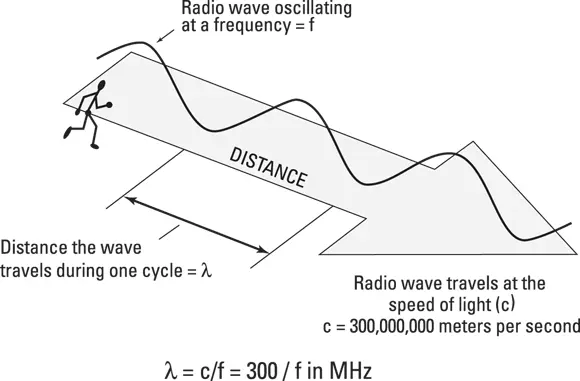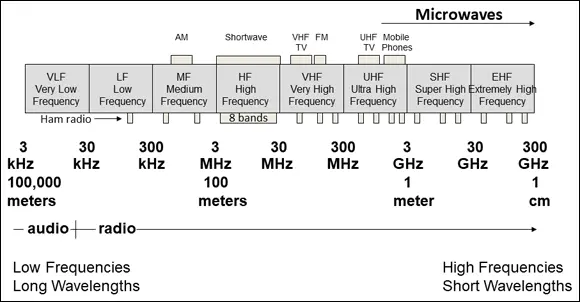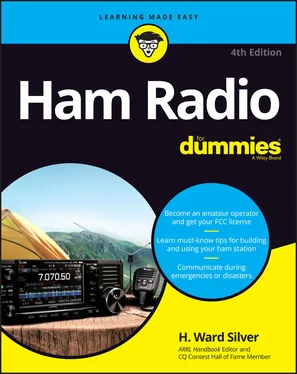1 ...8 9 10 12 13 14 ...25  The fields of a radio wave aren’t just one strength all the time; they oscillate (vary in direction back and forth) the way a vibrating guitar string moves above and below its stationary position. The exam asks about the time a field’s strength takes to go through one complete set of values — it’s called a cycle. The number of cycles in one second is the frequency of the wave, measured in hertz (abbreviated Hz).
The fields of a radio wave aren’t just one strength all the time; they oscillate (vary in direction back and forth) the way a vibrating guitar string moves above and below its stationary position. The exam asks about the time a field’s strength takes to go through one complete set of values — it’s called a cycle. The number of cycles in one second is the frequency of the wave, measured in hertz (abbreviated Hz).
The wave is also moving at the speed of light, which is constant. If you could watch the wave oscillate as it moved, you’d see that the wave always moves the same distance — one wavelength — during one cycle (see Figure 2-3). The higher the wave’s frequency, the faster a cycle completes and the less time it has to move during one cycle. High-frequency waves have short wavelengths, and low-frequency waves have long wavelengths.

Courtesy American Radio Relay League
FIGURE 2-3:As a radio wave travels, its fields oscillate at the frequency of the signal. The distance covered by the wave during one complete cycle is its wavelength.
If you know a radio wave’s frequency, you can figure out the wavelength because the speed of light is always the same. Here’s how:
Wavelength = Speed of light / Frequency of the wave
Wavelength in meters = 300,000,000 / Frequency in hertz
Similarly, if you know how far the wave moves in one cycle (the wavelength), you also know how fast it oscillates because the speed of light is fixed:
Frequency in hertz = 300,000,000 / Wavelength in meters
Frequency is abbreviated as f, the speed of light as c, and wavelength as the Greek letter lambda (λ), leading to the following simple equations:
f = c / λ and λ = c / f
The higher the frequency, the shorter the wavelength, and vice versa.
 If you need some help with the math in this book (although I’ve used very little) there is a handy Radio Math supplement on this book’s web page (see the Introduction). The supplement also lists a number of online references for even more help!
If you need some help with the math in this book (although I’ve used very little) there is a handy Radio Math supplement on this book’s web page (see the Introduction). The supplement also lists a number of online references for even more help!
 Radio waves oscillate at frequencies between the upper end of human hearing at about 20 kilohertz, or kHz ( kilo is the metric abbreviation meaning 1,000), on up to 1,000 gigahertz, or GHz ( giga is the metric abbreviation meaning 1 billion). They have corresponding wavelengths from hundreds of meters at the low frequencies to a fraction of a millimeter (mm) at the high frequencies. As an example, AM broadcast waves have frequencies of about 1 MHz and wavelengths of 300 meters or so. FM broadcast radio has a much higher frequency, around 100 MHz, so the wavelength is shorter, about 3 meters. WiFi waves (WiFi is a radio system, too!) are about ⅛ meter long. The exam includes several questions about frequency and wavelength.
Radio waves oscillate at frequencies between the upper end of human hearing at about 20 kilohertz, or kHz ( kilo is the metric abbreviation meaning 1,000), on up to 1,000 gigahertz, or GHz ( giga is the metric abbreviation meaning 1 billion). They have corresponding wavelengths from hundreds of meters at the low frequencies to a fraction of a millimeter (mm) at the high frequencies. As an example, AM broadcast waves have frequencies of about 1 MHz and wavelengths of 300 meters or so. FM broadcast radio has a much higher frequency, around 100 MHz, so the wavelength is shorter, about 3 meters. WiFi waves (WiFi is a radio system, too!) are about ⅛ meter long. The exam includes several questions about frequency and wavelength.
The most convenient two units to use in thinking of radio wave frequency (RF) and wavelength are megahertz (MHz; mega means 1 million) and meters (m). The equation describing the relationship is much simpler when you use MHz and m:
f = 300 / λ in m and λ = 300 / f in MHz
For example, a wave with a frequency of 3.75 MHz has a wavelength of 300 / 3.75 = 80 meters. Similarly, a wavelength of 2 meters corresponds to a frequency of 300 / 2 = 150 MHz.
 If you aren’t comfortable with memorizing equations, an easy way to convert frequency and wavelength is to memorize just one combination, such as 300 MHz and 1 meter or 10 meters and 30 MHz. Then use factors of ten to move in either direction, making frequency larger and wavelength smaller as you go.
If you aren’t comfortable with memorizing equations, an easy way to convert frequency and wavelength is to memorize just one combination, such as 300 MHz and 1 meter or 10 meters and 30 MHz. Then use factors of ten to move in either direction, making frequency larger and wavelength smaller as you go.
The range, or spectrum, of radio waves is very broad (see Figure 2-4). Tuning a radio receiver to different frequencies, you hear radio waves carrying all kinds of different information. These radio waves are called signals. Signals are grouped by the type of information they carry in different ranges of frequencies, called bands. FM broadcast-band stations, for example, transmit signals with frequencies between 88 and 108 MHz. That’s what the numbers on a radio display mean — 88 for 88 MHz and 108 for 108 MHz, for example. Bands help you find the type of signals you want without having to hunt for them over a wide range.

Courtesy American Radio Relay League
FIGURE 2-4:The radio spectrum extends over a wide range of frequencies and wavelengths.
 The different users of the radio spectrum are called services, such as the Broadcasting Service or the Amateur Radio Service. Each service gets a certain amount of spectrum to use, called a frequency allocation. Amateur radio, or ham radio, has quite a number of allocations sprinkled throughout the radio spectrum. Hams have access to many small bands; I get into the exact frequencies of the ham radio bands in Chapter 8.
The different users of the radio spectrum are called services, such as the Broadcasting Service or the Amateur Radio Service. Each service gets a certain amount of spectrum to use, called a frequency allocation. Amateur radio, or ham radio, has quite a number of allocations sprinkled throughout the radio spectrum. Hams have access to many small bands; I get into the exact frequencies of the ham radio bands in Chapter 8.
Radio waves at different frequencies act differently in the way they travel, and they require different techniques to transmit and receive. Because waves of similar frequencies tend to have similar properties, the radio spectrum hams use is divided into five segments:
Low Frequency (LF) and Medium Frequency (MF): Frequencies from 30 kHz to 300 kHz and from 300 kHz to 3 MHz. This segment includes AM broadcasting, radionavigation transmitters, and two ham bands.
Shortwave or High Frequency (HF): Frequencies from 3 to 30 MHz. This segment — the traditional shortwave band — includes shortwave broadcasting; eight ham radio bands; and ship-to-shore, ship-to-ship, military, and Citizens Band users.
Very High Frequency (VHF): Frequencies from 30 MHz to 300 MHz. This segment includes TV channels 2 through 13, FM broadcasting, three ham bands, public safety and commercial mobile radio, and military and aviation users.
Ultra High Frequency (UHF): Frequencies from 300 MHz to 3 GHz. This segment includes TV channels 14 and higher, two ham bands, cellular phones, public safety and commercial mobile radio, and military and aviation users.
Microwave: A general term for frequencies above 1 GHz. This segment includes GPS; digital wireless telephones; WiFi wireless networking; microwave ovens; eight ham bands; satellite TV; and numerous public, private, and military users.
 Because a radio wave has a specific frequency and wavelength, hams use the terms frequency and wavelength somewhat interchangeably. (The 40 meter and 7 MHz ham bands are the same thing, for example.) I use both terms in this book so that you become used to interchanging them as hams are expected to do.
Because a radio wave has a specific frequency and wavelength, hams use the terms frequency and wavelength somewhat interchangeably. (The 40 meter and 7 MHz ham bands are the same thing, for example.) I use both terms in this book so that you become used to interchanging them as hams are expected to do.
Читать дальше

 The fields of a radio wave aren’t just one strength all the time; they oscillate (vary in direction back and forth) the way a vibrating guitar string moves above and below its stationary position. The exam asks about the time a field’s strength takes to go through one complete set of values — it’s called a cycle. The number of cycles in one second is the frequency of the wave, measured in hertz (abbreviated Hz).
The fields of a radio wave aren’t just one strength all the time; they oscillate (vary in direction back and forth) the way a vibrating guitar string moves above and below its stationary position. The exam asks about the time a field’s strength takes to go through one complete set of values — it’s called a cycle. The number of cycles in one second is the frequency of the wave, measured in hertz (abbreviated Hz).
 If you aren’t comfortable with memorizing equations, an easy way to convert frequency and wavelength is to memorize just one combination, such as 300 MHz and 1 meter or 10 meters and 30 MHz. Then use factors of ten to move in either direction, making frequency larger and wavelength smaller as you go.
If you aren’t comfortable with memorizing equations, an easy way to convert frequency and wavelength is to memorize just one combination, such as 300 MHz and 1 meter or 10 meters and 30 MHz. Then use factors of ten to move in either direction, making frequency larger and wavelength smaller as you go.











